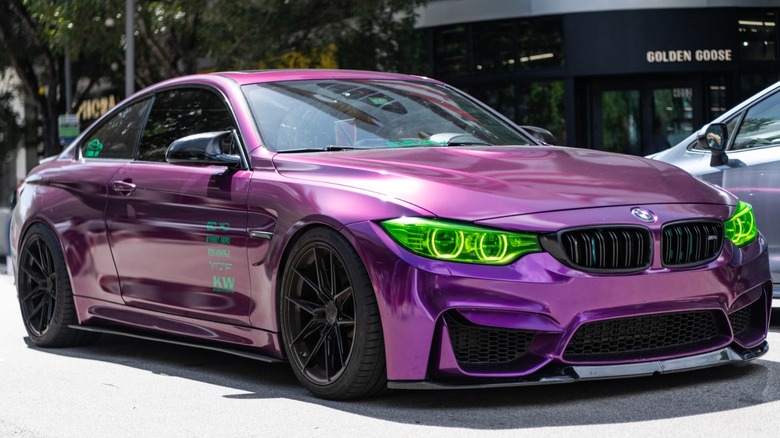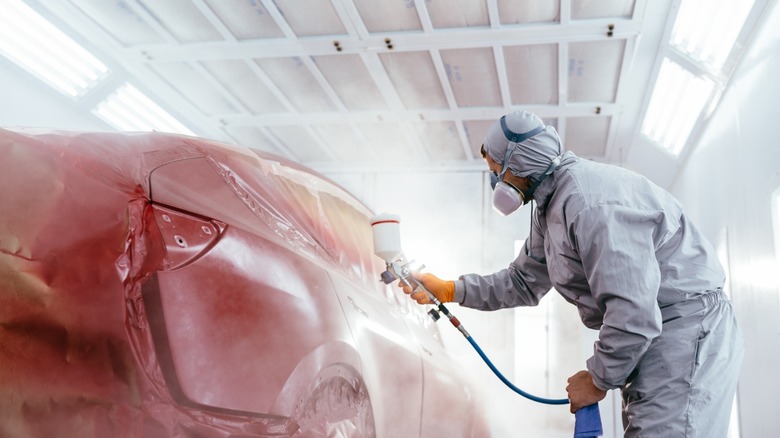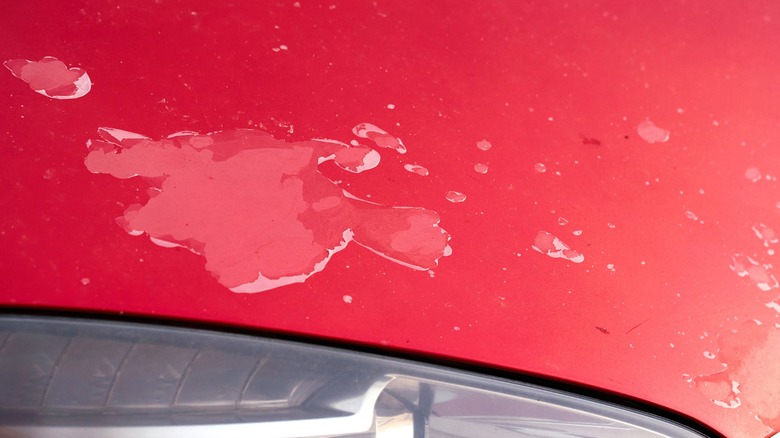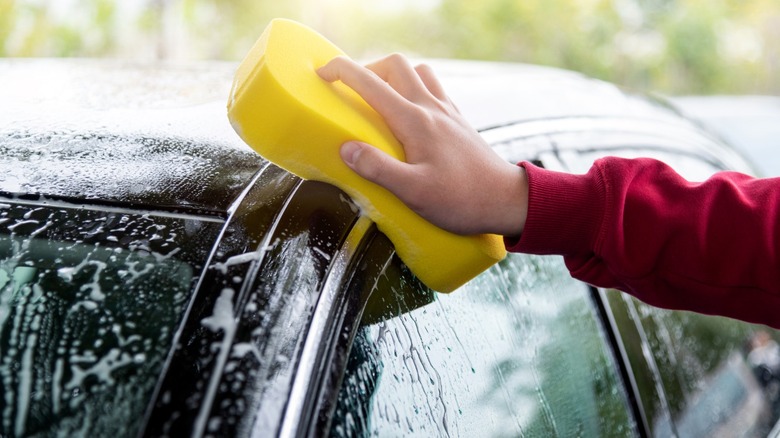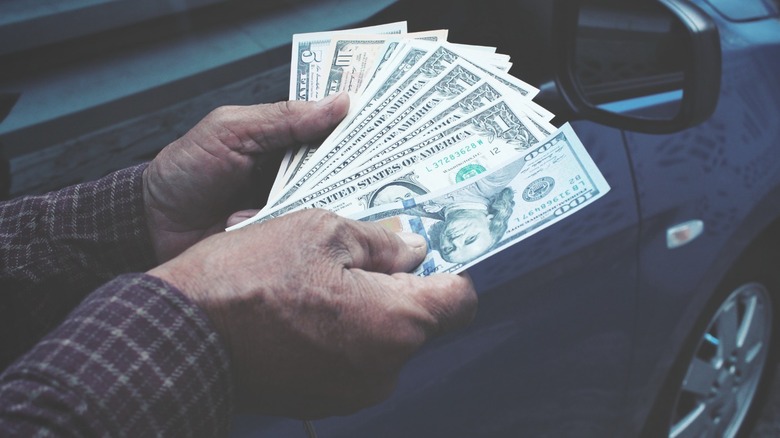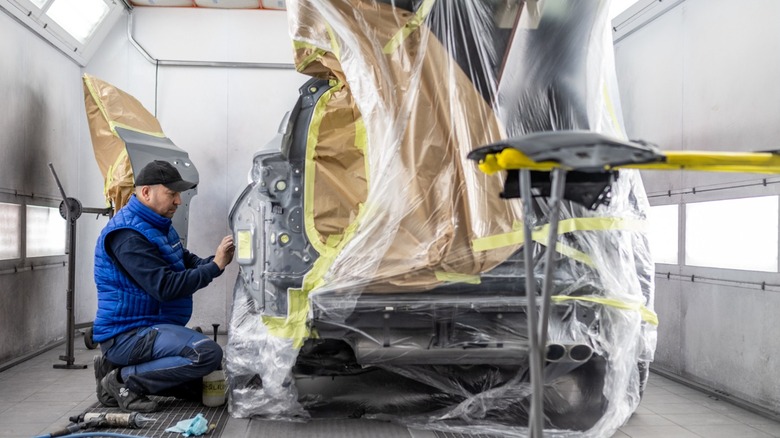Should You Wrap Or Paint Your Car? Here Are The Pros And Cons
The outside of your car has seen better days. It's been sitting out in the sun so long you forgot what the original color was. Or maybe it has a few scratches here and there from those times you drove a little too close to the speakers at the Burger King drive-thru. We're not here to judge. No doubt, you're thinking about painting your car. But have you thought about wrapping it instead?
Maybe you thought that car wrapping was just for the random realtor who wants to turn her Kia Soul into a roving billboard for her business. Not so, friend. Car wrapping isn't just for tacky advertising anymore. Just about anyone can have their car wrapped in their favorite color. Tesla has even offered wrapping Model 3s and Model Ys for their customers. But is wrapping your car any better than painting it? The answer depends on a lot of things, such as your budget, how long you need it to last, how much effort you're willing to put in to maintaining it, whether you care about the resale value, and how important your carbon footprint is to you.
One advantage of wrapping a car is that it can be initially less expensive than painting one. But you'll need to balance that with the fact that vinyl car wraps need to be replaced more often than a car typically needs to be repainted. The resale value is often not as high for a car that is wrapped versus one with a paint job that has held up. On the other hand, car wraps require less maintenance, are better for the environment, and offer more design options.
Wrapping vs. painting your car: which costs more
If you're on a tight budget, those $499 paint specials might seem pretty tempting. And the job these shops do for that price can turn out just fine, so long as you don't stare too long or squint when you look at it. What's a little overspray here and there when you can save a few hundred bucks? You probably didn't need to see out of that window, anyway.
But, if you care about what others will think, you'll probably have to spend a little more than you would for those specials. How much can you expect to pay? If you're wanting a paint job that includes sanding, rust removal, and more than one coat of paint, you're going to be looking at $1,000 to $4,500. Now, if you want to get fancy with custom colors and designs, that can run you anywhere from $5,000 to $20,000. The cost of a paint job depends on the prep work required, the number of coats, and the kind of paint used.
Wrapping your car, on the other hand, can cost as little as $600 for a partial job, depending on how much of your car you want wrapped. But a standard full wrap will run from $2,000 to $6,000, depending on the size of your car. Car wraps can get fancy as well, coming in premium textures and finishes or even changing colors. Those kinds of jobs will run you from $6,000 to over $10,000. Aside from the type of material used, the cost largely depends on the size of your vehicle — like wrapping an SUV – and the time involved in installation.
Wrapping vs. painting your car: how long it lasts
The phrase, "You get what you pay for," applies just as much to car painting and wrapping as anything else. Sometimes cost isn't just about the upfront price of the job. How many times will you have to get your car painted or recovered for the time that you own it? A cheaper wrapping job isn't really cheaper if you have to do it twice as often as you would a decent paint job.
Standard vinyl wraps can last from five to seven years, and wraps with premium finishes can last longer than that. A good paint job, on the other hand, can last from 10 to 15 years, especially if you're diligent about washing and waxing it. Springing for a ceramic coat can make your paint job last even longer.
But there's also a lot that can affect a paint job's longevity that might be outside of your control. You may have to park your car outside all day, and you live in an area like Florida where the sun is particularly brutal. Or just the opposite, you might live in a colder climate where the roads are slushy and salty in the winter. Maybe you have to travel on a lot of gravel roads, which can cause wear and damage from all of the dirt and rocks that fly up and hit your car every now and then. And then there's the occasional bird that may show an utter lack of respect for the finish on your car. Of course, all of those things can affect vinyl wraps as well.
Wrapping vs. painting your car: how much of a pain is it to maintain?
Maintaining the gloss of a paint job involves some waxing. A good coat of wax now and then keeps your car looking shiny and new. But more than that, it can keep your paint job from fading in the sun and even provide some minimal protection against small scratches. Of course, you'll also want to wash your car on a regular basis, as dirt, sap, and bird poop are not kind to a paint job.
Maintaining vinyl wrap, on the other hand, is simple – just wash it with pH-balanced soap. That's it, no waxing is required. However, if you enjoy the convenience of taking your car through the automatic car wash, even though the kid at the entrance keeps trying to upsell you on 12 different kinds of rinses and soap applications, that will now be a thing of the past. Those big brushes in automatic car washes can tear vinyl wrapping. The same goes for spraying your vinyl wrap with a power washer, which can also damage vinyl. Expect to spend part of your Saturday afternoons hand washing your car with a sponge and garden hose.
Wrapping vs. painting your car: what happens to the resale value
For a majority of people, the time will come to sell your car. Maybe you'll trade it in for something that still has its first coat of paint and looks fine (one can only dream). But what will having a wrapper around your car do to its resale or trade-in value? Will anyone even want it, or will you be laughed off of the dealership lot?
It's not as dramatic as all of that, but a paint finish that is in good condition generally will bring a higher resale value than a wrap will. That's especially true if the paint job is still the original. But here's the thing, car wraps can easily be removed by professionals before you resell the car, and they protect the paint underneath. You may find after removing the wrap that your car's paint looks exactly the way it did when you wrapped it.
Of course, removing vinyl wrap does come with a cost. Getting a wrap professionally removed from a small car will run you anywhere from $300 to $600. Sedans, SUVs, and trucks, on the other hand, can cost $500 to $1,200. Having the wrap taken off of your Lamborghini or Rolls-Royce may set you back over $2,000. If you're handy with a heat gun, you can save some money by removing the wrap yourself. Tools and materials will cost around $50 to $150. Just be careful not to damage the paint with too much heat.
Wrapping vs. painting your car: impact on the environment
If you're the kind of person who rinses out their empty spaghetti sauce jars before throwing them into the recycling bin or chooses restaurants that offer paper straws, you might be interested in whether wrapping or painting your car has the smaller carbon footprint. The fact is, neither method is perfectly friendly to Mother Nature. Wrapping a car, however, is not as unfriendly to the environment as painting one. Car wraps do not require primer or clear coat, both of which contain volatile organic compounds (VOCs).
There are also no leftover paint, paint cans, tape, or masks when installing a vinyl wrap, meaning there is much less waste. Then there's the amount of water that's used when painting, something that's not necessary for a car wrap. Even transporting vinyl wrap is less costly to the environment due to its light weight. But what about when it's time for the wrap to be removed, doesn't it end up in a landfill? Actually, some wraps are made to be biodegradable or even recyclable.
That's not to say vinyl wrapping has no negative impact on the environment. It is made from polyvinyl chloride, which is produced using toxic additives like phthalates. However, some manufacturers sell phthalate-free options. So, which is better, painting a car or wrapping it? That depends. In the short term, wrapping can be cheaper, and it offers more design options, and it's also better for the environment. In the long term, though, painting offers a better resale value and won't need to be redone as often.
